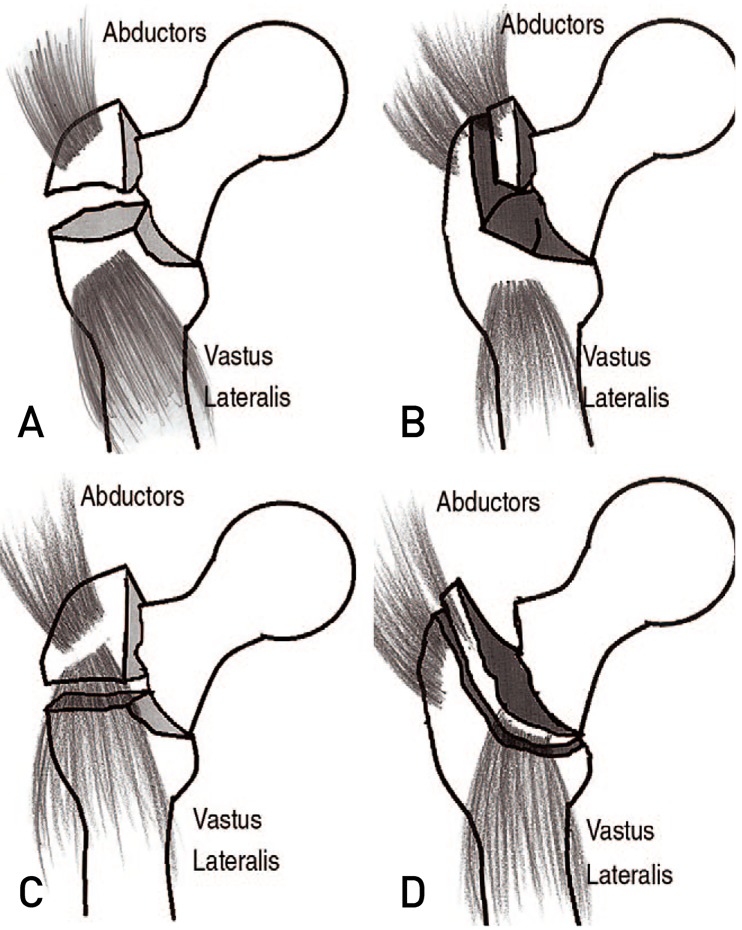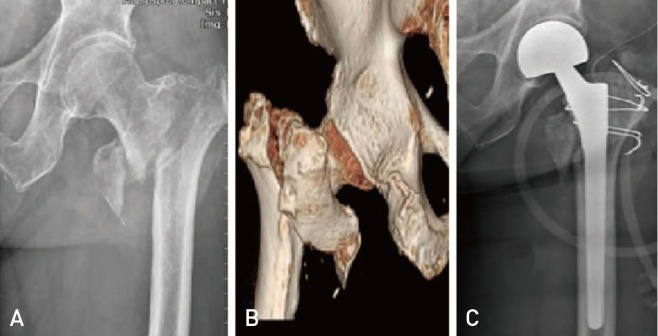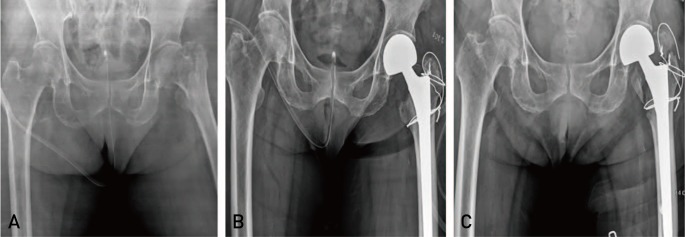1. Dhanwal DK, Dennison EM, Harvey NC, Cooper C. Epidemiology of hip fracture: Worldwide geographic variation. Indian J Orthop. 2011; 45:15–22. PMID:
21221218.

2. Broos PL, Rommens PM, Geens VR, Stappaerts KH. Pertrochanteric fractures in the elderly. Is the Belgian VDP prosthesis the best treatment for unstable fractures with severe comminution? Acta Chir Belg. 1991; 91:242–249. PMID:
1950312.
3. Fan L, Dang X, Wang K. Comparison between bipolar hemiarthroplasty and total hip arthroplasty for unstable intertrochanteric fractures in elderly osteoporotic patients. PLoS One. 2012; 7:e39531. PMID:
22745778.

4. Celiktas M, Togrul E, Kose O. Calcar preservation arthroplasty for unstable intertrochanteric femoral fractures in elderly. Clin Orthop Surg. 2015; 7:436–442. PMID:
26640625.

5. Stern MB, Goldstein TB. The use of the Leinbach prosthesis in intertrochanteric fractures of the hip. Clin Orthop Relat Res. 1977; (128):325–331.

6. Sun D, Park BS, Jang GI, Lee B. The fixation method according to the fracture type of the greater trochanter in unstable intertrochanteric fractures undergoing arthroplasty. Hip Pelvis. 2017; 29:62–67. PMID:
28316964.

7. Park BJ, Cho HM, Min WB. A comparison of internal fixation and bipolar hemiarthroplasty for the treatment of reverse oblique intertrochanteric femoral fractures in elderly patients. Hip Pelvis. 2015; 27:152–163. PMID:
27536619.

8. Cho HM, Lee SR, Park MS, Chung WC. Standard type cemented hemiarthroplasty with double loop and tension band wiring for unstable intertrochanteric fractures in the elderly. J Korean Hip Soc. 2010; 22:159–165.

9. Hamadouche M, Zniber B, Dumaine V, Kerboull M, Courpied JP. Reattachment of the ununited greater trochanter following total hip arthroplasty. The use of a trochanteric claw plate. J Bone Joint Surg Am. 2003; 85:1330–1337. PMID:
12851359.
10. Kim WY, Han CH, Park JI, Kim JY. Failure of intertrochanteric fracture fixation with a dynamic hip screw in relation to preoperative fracture stability and osteoporosis. Int Orthop. 2001; 25:360–362. PMID:
11820441.

11. Grimsrud C, Monzon RJ, Richman J, Ries MD. Cemented hip arthroplasty with a novel cerclage cable technique for unstable intertrochanteric hip fractures. J Arthroplasty. 2005; 20:337–343. PMID:
15809952.

12. Kim JH, Lee S, Jeong SY, Park JS, Seo YH. Bipolar hemiarthroplasty using the greater trochanter reattachment device (GTRD) for comminuted intertrochanteric fracture in elderly patients. J Korean Hip Soc. 2004; 16:441–446.
13. Choi DH, Heo JY, Jang YJ, Chung YY. Fixation of the greater trochanter in arthroplasty for unstable intertrochnateric fracture. J Korean Fract Soc. 2014; 27:58–64.

14. Clawson DK. Intertrochanteric fracture of the hip. Am J Surg. 1957; 93:580–587. PMID:
13403091.

15. Koyama K, Higuchi F, Kubo M, Okawa T, Inoue A. Reattachment of the greater trochanter using the Dall-Miles cable grip system in revision hip arthroplasty. J Orthop Sci. 2001; 6:22–27. PMID:
11289581.

16. Kim WY, Han CH, Ji JH, Kim YY, Lee KS, Lee SW. Fixation for reattachment of trochanteric fragment in pertrochanteric fracture treated with bipolar hemiarthroplasty. J Korean Hip Soc. 2006; 18:67–72.

17. Suh YS, Choi SW, Park JS, Yim SJ, Shin BJ. Comparison between the methods for fixation of greater trochanteric fragment in cemented bipolar hemiarthroplasty for unstable intertrochanteric fracture. J Korean Hip Soc. 2008; 20:104–109.

18. Chin KR, Brick GW. Reattachment of the migrated ununited greater trochanter after revision hip arthroplasty: the abductor slide technique. A review of four cases. J Bone Joint Surg Am. 2000; 82:401–408. PMID:
10724232.
19. Wang JW, Chen LK, Chen CE. Surgical treatment of fractures of the greater trochanter associated with osteolytic lesions. J Bone Joint Surg Am. 2005; 87:2724–2728. PMID:
16322623.







 PDF
PDF ePub
ePub Citation
Citation Print
Print







 XML Download
XML Download